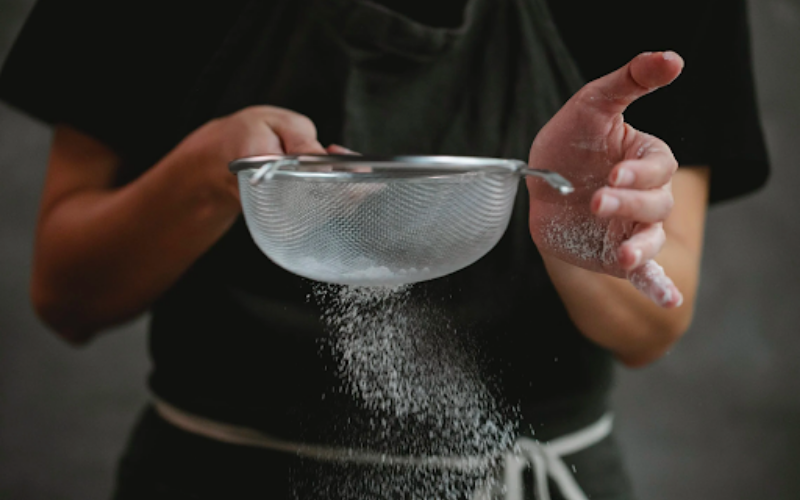How To Clean A Sieve Correctly
For those of you wondering ‘how to clean a sieve correctly’ you have certainly come to the right place. We understand as key providers of baking machinery/utensils that the sieve is an integral part of any kitchen/bakery setting. We also recognise that sieves can be incredibly troublesome to clean due to the tiny, unforgiving mesh holes that can easily trap food. As such, we are going to discuss how to clean a sieve correctly as well as provide you with some neat tips and tricks on how to improve the longevity of these pieces of baking equipment.
How to Clean A Sieve
Below, we have listed the top actions points on how to clean a sieve effectively which will increase the longevity of these nifty pieces of equipment.
- Clean Immediately
The first tip we are going to discuss when cleaning a mesh sieve is to think about cleaning it immediately after use. Failure to do this will cause the food contents to harden, and the more it hardens, the worse and more difficult it will be to clean. This can be anything from lightly tapping the side of the sieve on the sink, gently dislodging any excess food, or blasting the sieve through the tap (along with soap) to forcefully drain any leftover substances. Since a mesh sieve has many small holes, you will need to thoroughly inspect the sieve to ensure that all contents are removed from the utensil. This is because if you are planning on utilising the sieve again, you will not want any leftover food from the previous session contaminating your ingredients. This is known as cross contamination and is an absolute taboo in any kitchen setting.
- Use A Washing Scrub With Bristles
The next tip we recommend when discussing how to clean a sieve correctly is to utilise a washing scrub, particularly one with small bristles, that can get into even the smallest of areas. Due to the nature of how a sieve is manufactured and utilised, there will be miniscule holes that can easily trap food which can be a nightmare if you want to maintain strong hygiene practices. However, with a washing scrub, you can easily dislodge the contents on the sieve and give it a deep and thorough clean.
Not to mention, If you fail to dislodge any food from the mesh sieve soles, it will render your sieve useless and will make your baking process more time consuming or ineffective all together.
Pro tip – be sure to let the sieve soak before using the bristle brush for at least 15 minutes. By letting the sieve soak in very hot water, it further dislodges and removes any bacteria that may be present on the sieve from previous use and will make thoroughly cleaning it that much more straightforward.
Dry it Out Properly
This may be of a surprise to many people but towel drying isn’t actually an effective solution when cleaning your mesh sieve. Since water itself can get stuck in the mesh, the only suitable way to guarantee that the sieve will completely dry out is to let it air dry on the kitchen counter. Not to mention, if your towel isn’t washed sufficiently enough beforehand, you can transfer unwanted bacteria from dirty towels straight back onto your already clean sieve, something that you definitely do not want.
Pro tip – if you are feeling adventurous and really want to make sure that your sieve is fully dried and free from reluctant bacteria/particles from latching on to the sieve, you can place the sieve directly over a burner flame and can singe off any lingering particles. However, it should be noted that if your sieve isn’t particularly hard wearing or thermal resistant, you can accidentally melt the metal which may deem your sieve useless.
Things to Consider
- Be Mindful of Heat
As we have just mentioned, you can place your sieve under a burner flame to singe off any unwanted particles to really give it a deep and thorough clean. Carefully rotating the sieve over an open flame on the stovetop can rid it from harmful bacteria, however, there is every possibility that you can accidentally melt the mesh and ruin the strainer if the flame is too hot. As such, always pay attention to the temperature when heating your equipment.
- Use A Toothbrush
If you don’t have a bristle brush handy, you can use the next best alternative which can be a toothbrush. A toothbrush, as we are sure you are aware, possesses very little bristles where you would normally brush your teeth which can act as a superb substitute and can easily dislodge any stubborn food trapped in your sieve. Simply wet the toothbrush in warm water and scrub away. As a side note, it is advised that you purchase a new toothbrush after use as if you are using cleaning chemicals to wash your sieve, you don’t want this transferring from the toothbrush into your mouth.
- Purchase A New One
If your sieve is beyond recovery, you can always purchase a new one. Thankfully, here at Creeds Direct, we stock high quality and trusted sieves that can be utilised all year round. All sieves are made fully of stainless steel for strength and durability purposes and are of course, very much affordable. Get in contact with us today if you are interested in purchasing a new and reliable sieve for your kitchen applications.

